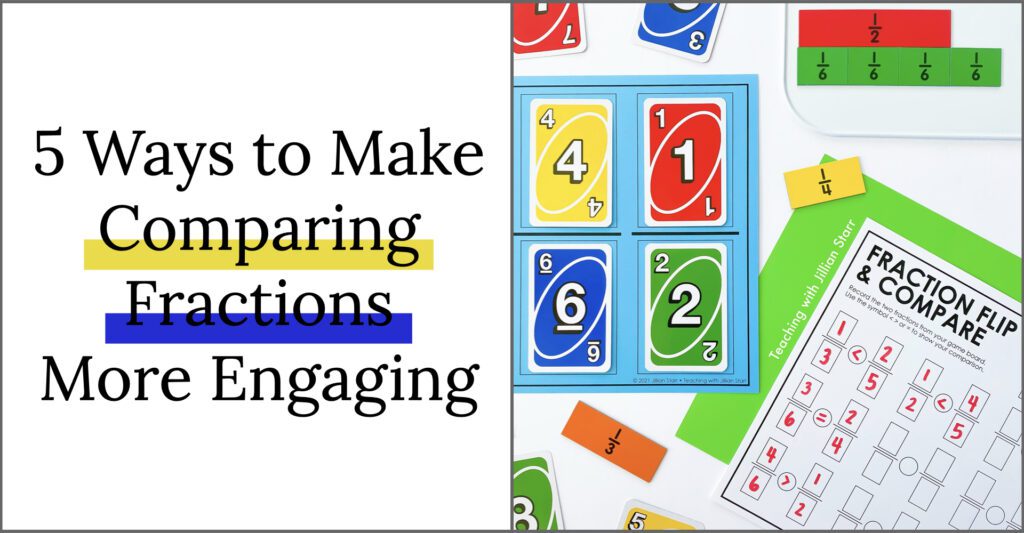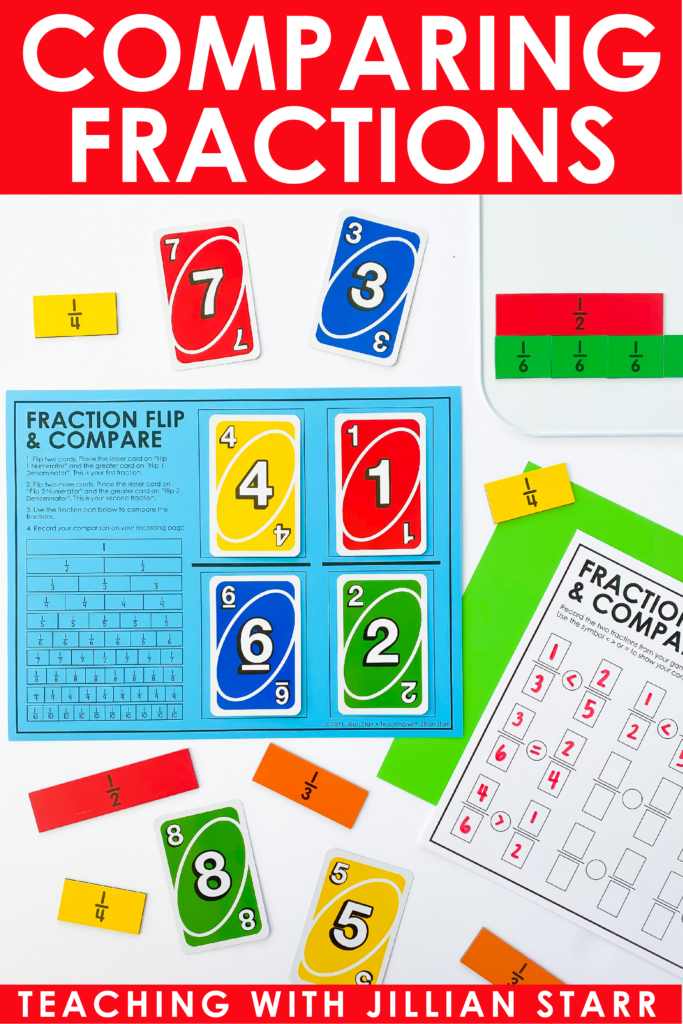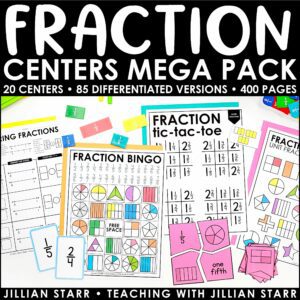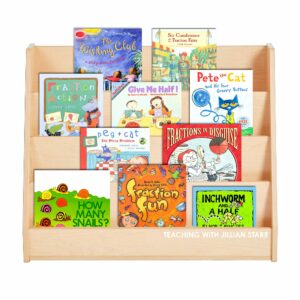

Comparing fractions is a BIG step up from simply identifying fractions and partitioning shapes. We are now asking students to look at two different written fractions and use comparing language like greater than, less than, or equal to. It’s no joke!
If you have ever taught comparing fractions before, you know that the complex nature of the content can sometimes make it hard for students to fully engage in the learning. In this post, I’ve outlined five of my favorite ways to making comparing fractions more engaging for your students!
Comparing Fractions in Art & Photography
If you didn’t know, Number Talks are one of my absolute favorite things! They build such a strong community of mathematicians and create amazing opportunities for students to develop communication skills around their mathematical thinking!
Fractions can be such a fun topic for Number Talks. While we can absolutely put a few fractions on the board and have students compare them (these are PERFECTLY valid and useful Number Talks,) it can also be fun to switch things up! One of my favorite ways is to project a photo and have students find fractions within them.
Some examples could include artwork by artists like Piet Mondrian (See a likeness of his work below). They are such great conversation starters and offer so many possibilities to discuss colors and the representation of different fractions. I also love that number talks like this have multiple access points, so students can modify or extend the conversation easier to challenge themselves at their “just right level.”
Other fun images include buildings, windows, organization solution photos (you know… the ones with dozens of cubbies!) There are unlimited options with these!
Create a Fraction Gallery Walk
After modeling how to discuss fractions within photos/paintings during your Number Talks, you can turn this into an independent center in your classrooms! Post photos/paintings around your room, or make photocopies of them for students to put in their math journals and let them start writing about what they see. Allow them to draw, write and/or use numbers to share their thinking about the different fractions they see.
You can add a “word bank” to this activity if you’d like to push them to begin comparing the fractions in certain ways (e.g. greater than, less than, whole, equal to…etc).
Scaffolding Student Work
Prior to asking students to begin comparing fractions independently, I am sure to include several number talks and mini-lessons about:
- Comparing fractions with the same numerator
- Comparing fractions with the same denominator
- Using benchmark fractions for comparisons
However, once we’ve built a foundational understanding and developed some helpful strategies, it’s time to let them give it a try on their own… with some scaffolding of course!
I have some favorite go-to activities when it comes to helping students compare fractions. They start off REALLY simple and can be used over and over again to get repeated but meaningful practice (I personally stay away from one-and-done worksheets as much as possible).


These domino fractions activities (also available with dice in case you don’t have dominoes) have students comparing fractions with embedded visual supports.
For the first, I like having them partition and shade their shapes (we have already done some work around this together). By having those concrete visuals in place, students can more easily decipher which fraction is greater than the other and then write a comparison sentence. As they gain familiarity, I have them try to reason through the comparison first, and then use the visuals to confirm (or not) their initial thoughts.


The second version changes the visual to a number line. My students often struggle with fractions on a number line, so giving them lots of exposure and opportunities to work with them has been really helpful! I always try to do this one second, because then they are already familiar with the idea and the activity itself, so now all they have to do is focus on the number line.
Offering Choice over Comparing Fraction Activities
Whenever I offer my students CHOICE, engagement soars! That means I’m introducing a few different activities (it doesn’t have to be a lot, but 2-3) and allowing them to choose how they want to learn.
Two of my favorite activities to offer up to students as a choice are Fraction Flip & Compare (you might know it as the old card game, War) and one I created with my students called “Order’s Up!”


Fraction Flip & Compare is super easy to implement because students often have previous experience with the game. I personally like to have a board or some visual that helps students separate the numerator and denominator.
I have students keep a recording sheet when they play for 3 reasons:
- It allows me to see their understanding, even if I’m not there because I’m working with a small group.
- It holds students accountable for their work. Implementing recording sheets has been a great classroom management hack!
- Gives me a neat and tidy space to include a fraction bar model to support students as they become more independent.


Order’s Up! Is another class favorite (I mean, it’s pizza!) This activity is more difficult than Fraction Flip & Compare because it moves from comparing two fractions to ordering four different fractions from least to greatest. Again, I make sure to include a fraction bar model for support and often have students keep a recording page for all of the same reasons mentioned above.
My students LOVE having the option to choose how they work on comparing fractions. When they are motivated by choice, their engagement level goes up. When their engagement level goes up, their attention increases and they’re more likely to improve their understanding. WIN!!!



Free Comparing Fractions Activity
Do your students struggle to compare fractions using benchmark fractions? Grab this free download with embedded visual supports to help them practice!
Group Games They Can’t Get Enough Of!
If you’ve frequented my blog before, you know that my favorite small group game is Kaboom! I swear you can use this game for just about every skill in every subject you teach…. so of course, I use it when I teach comparing fractions!
If you aren’t familiar with Kaboom, you are definitely going to want to check out this blog post where I break it down and give some helpful tips for how to get it set up and organized in your classroom.


Years ago, I was going through the interview process for a new teaching position and it came time for the administration to come and watch a demo lesson. I actually put this EXACT game at one of my math centers while I was teaching a small guided math group. (Yes, I trust this game enough to do it during a formal observation during an interview.)
I got a lot of positive feedback, both regarding the level of engagement and student accountability with the recording page. And… in case you were curious, I got the job!
I hope these tips were helpful. ALL of the student games and activities can be found in my Fraction Mega Pack, and it isn’t called a mega pack for nothing! It is nearly 400 pages of ALL of my favorite games to teach fractions in third grade. Click HERE to check it out!




















Leave a Comment